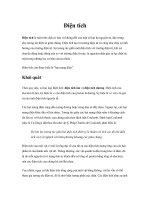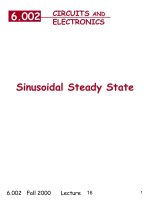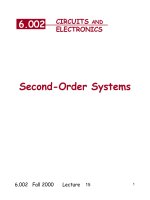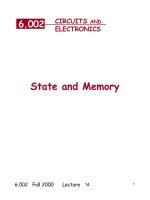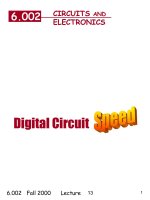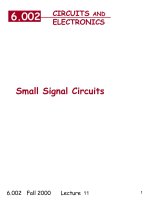Tài liệu Power Electronics ppt
Bạn đang xem bản rút gọn của tài liệu. Xem và tải ngay bản đầy đủ của tài liệu tại đây (130.2 KB, 13 trang )
ENGNG3070 Power Electronics Devices, Circuits and Applications
E Levi, Liverpool John Moores University, 2002
95
()
[]
()
[]
()
[]
()
[]
()
[]
aff
VV
k
IVZVkXX
VV VV
IVaXX xx
IVaXX xx
n
kDC
sk k k k s r
DC DC
ssr
ssr
== =
=
== +
== ==
=+= +=
=+= +=
//.
.
... .
.....
25 50 05
21
21
5
23
21
7
165
5 23 5 05 15 15 307
71657051515157
57
55
77
π
ππ
σσ
σσ
σσ
VV
A
A
Stator current higher harmonics therefore have the same value regardless of the operating frequency.
This is so due to the fact that DC voltage and hence rms values of all the voltage harmonics change
proportionally to operating frequency. As leakage reactances are proportional to fundamental
frequency as well, ratio of phase voltage harmonic rms value to sum of leakage reactances for the
given harmonic remains constant regardless of the fundamental frequency.
6.5.2 PWM Operation of a Voltage Source Inverter
In all the analysis so far it was assumed that the inverter operates in 180 degrees
conduction mode and that variation of the inverter output voltage magnitude is achieved by
rectifier control. Such a solution is nowadays rarely applied. Instead, the inverter is operated in
pulse width modulated (PWM) mode and is supplied from a diode bridge rectifier (single-phase
or three-phase), so that input DC voltage of the inverter is constant. Variation of both inverter
output voltage and output frequency is now achieved by the inverter, due to operation in the
PWM mode. The idea of PWM is explained using single-phase VSI circuit of Fig. 3.9. The
most frequently utilised method of PWM is the so-called sinusoidal PWM technique, in which
a reference signal - a sine wave of desired amplitude and frequency - is compared with a
triangular carrier wave of constant amplitude and frequency. The instants for turn-on and turn-
off of semiconductors in Fig. 3.9 are then determined with intersections of the reference signal
and the carrier wave. Switches are turned on and off in pairs: S1 and S2 are always together
either on or off and similarly, S3 and S4 are always together either on or off. The advantage of
this approach is two-fold. First of all, inverter now becomes capable of controlling both the
frequency and the first harmonic magnitude, so that there is no need for application of a
controllable rectifier. Instead, a diode rectifier is used. Secondly, switching now occurs at high
frequency determined with the carrier wave frequency. This enables faster control and
simultaneously greatly improves harmonic spectrum of the load current. Inverter output
voltage now does not contain low order harmonics (the fifth, seventh, etc.). Instead, harmonics
are situated around multiples of the switching frequency (i.e., triangular carrier wave
frequency). Thus, if switching frequency is 5 kHz (typical value nowadays), then the inverter
output voltage will contain, apart from fundamental, higher harmonics whose frequencies are
around 5 kHz, 10 kHz, 15 kHz etc. If the motor operates with 50 Hz fundamental frequency,
then 5 kHz means that the order of the harmonic is around 100 (rather than 5, as it is in the
simple VSI discussed previously). As reactance of the motor (Fig. 6.14) is 100 times greater at
5 kHz than at 50 Hz (rather than only five times greater, as the case is for harmonic frequency
of 250 Hz), harmonic currents in the motor will be very small.
The principle of sinusoidal PWM, as applied in the single-phase bridge inverter of Fig.
3.9, is illustrated in Fig. 6.15. The impact of variation of reference signal amplitude on output
voltage waveform is evident from Fig. 6.15. Widths of the pulses in the two cases shown differ
although output frequency and triangular carrier wave frequency are the same. The variation in
pulse widths leads to subsequent difference in the values of the first harmonic of the output
ENGNG3070 Power Electronics Devices, Circuits and Applications
E Levi, Liverpool John Moores University, 2002
96
voltage. It can be shown that the fundamental harmonic of the output voltage waveforms
shown in Fig. 6.15 equals in frequency and in amplitude the reference signal.
Reference and carrier signals
High amplitude of reference
v signal
V
Reference and carrier signals
Medium amplitude of reference
signal
v
V
Fig. 6.15: Sinusoidal PWM in single-phase bridge inverter for high and medium amplitudes of
the reference signal at same output frequencies.
Extension of the principle of PWM from single-phase to three-phase voltage source
inverter is rather straightforward. The reference sinusoidal voltage (which equals desired
fundamental voltage at the inverter output) is formed on the basis of the control law for given
operating point (say, V/f = V
n
/f
n
law). Thus the amplitude and the frequency of the reference
sinusoidal signal are those that want to be obtained at machine terminals. The reference
sinusoidal signal is further compared with the carrier signal (again, high frequency triangular
waveform). The instants of semiconductor switching in inverter legs are determined with
intersections of sinusoidal reference and triangular carrier wave. The three-phase inverter
requires three reference sinusoidal signals in order to achieve operation with three-phase
system of output voltages. The three sinusoidal reference signals have mutual displacement of
120 degrees. If triangular carrier frequency is sufficiently high, one carrier may be utilised for
all the three phases. It can be shown that although the output voltage is again composed of a
series of rectangular pulses, fundamental component of the output voltage is of the same
frequency and magnitude as the reference sinusoidal signal is.
Analysis of the PWM inverter output voltages is always conducted using the notion of
the ‘modulation index’. Modulation index m is defined as the ratio of the sinusoidal signal
ENGNG3070 Power Electronics Devices, Circuits and Applications
E Levi, Liverpool John Moores University, 2002
97
reference amplitude to the amplitude of the triangular carrier wave. Another frequently utilised
term is the frequency ratio F, which is defined as the ratio of the triangular carrier frequency to
the frequency of the reference signal. Hence
mV V F f f
ref tri tri ref
==
−−sin sin
and
(6.24)
If the drive is controlled using V/f = const. law, than the amplitude and the frequency of the
sinusoidal reference signal are varied to satisfy this law. Full PWM operation is possible only
for modulation index values between zero and one. If modulation index exceeds the value of
one, so called pulse-dropping region is entered. In this region reference signal is of higher
amplitude than the carrier signal and some of the intersections between the reference and the
carrier do not take place any more (i.e. some of the pulses are dropped - hence the name pulse
dropping). Eventually, if the modulation index is sufficiently high, the inverter essentially
reverts to six-step operation. In general, depending on the application, it is possible to realise
the PWM inverter fed drive in two ways: full PWM operation is maintained in the whole base
speed region (i.e. from zero to rated frequency) or full PWM operation takes place in part of
the base speed region only, while at rated frequency the inverter operates either with six-step
output voltage or with partial PWM (i.e. some pulses are dropped). This region of operation is
frequently called over-modulation. Note that the beneficial feature of PWM inverter, non-
existence of low order harmonics, holds true only so long as the full PWM operation is
preserved. The described two ways of operating the PWM inverter will require different input
DC voltage at rated output frequency. The amplitude of the fundamental output line-to-neutral
voltage for operation in the full PWM mode is given with
()
()
VmV
VmV
peak
DC
DC
1
1
2
22
=
=
(6.25)
while the corresponding output line-to-line fundamental rms voltage value for the six-step
operation is given in equation (6.19).
Example:
A three -phase 415 V, 50 Hz star-connected induction motor is to be supplied from a
three-phase voltage source inverter that is controlled using sinusoidal PWM. Calculate
the required inverter input DC voltage if: a) the inverter operates in the whole base
speed region with full PWM; b) inverter reverts to six-step operation at rated output
frequency.
Solution:
Fundamental component of the inverter line-to-line voltage has to be at 50 Hz equal to 415 V, rms,
regardless of the applied method of control, so that required phase to neutral fundamental component
has to be of 240 V rms. If full PWM operation takes place at 50 Hz, then from (6.25) one has
()
m
VmV V Vm
DC DC
=
=
Þ
===
1
2 2 2 2 2 2240 679
11
V
If the operation at 50 Hz is in six-step mode, then from (6.19)
VV VV
DC DC11
2
2 240 2 533=
Þ
== =
π
ππ
V/
Considering that the normal three-phase rectifier input voltage is 415 V line-to-line, then, assuming
almost infinite capacitance in the DC link, the DC voltage could at most be equal to the peak of the
input line-to-line voltage, 587 V. The standard practice is therefore to operate the inverter at rated
frequency in the pulse dropping mode, close to six-step waveform. If full PWM operation is needed at
rated frequency, then specially designed motors have to be used, whose rated voltage is below 415 V
but whose insulation is of higher rating.
ENGNG3070 Power Electronics Devices, Circuits and Applications
E Levi, Liverpool John Moores University, 2002
98
It is usually said that DC voltage utilisation in the PWM mode is poorer than in the six-step mode.
Given the DC voltage, maximum fundamental line-to-line voltage rms values are 61% and 78% of the
applied DC voltage for sinusoidal PWM (with m = 1) and six-step voltage, respectively.
In the past, when available switching frequencies of semiconductors were rather low, it
was customary to keep the frequency ratio F constant, so that good feature of the sinusoidal
PWM with regard to harmonic content was preserved at all operating frequencies. Nowadays,
semiconductor switching frequencies are for major part of the power region in the kHz region.
Typically, for small to medium powers, inverter switching frequency is of the order of 2 to 20
kHz. Consequently, carrier frequency is nowadays kept normally constant and only one carrier
is used for all the three reference signals.
In summary, it can be stated that operation of a VSI in PWM mode yields two
substantial benefits, when compared to operation in 180 degrees conduction mode. A diode
rectifier can be used instead of a controllable rectifier, since the inverter is now capable of
controlling both the frequency and the rms value of the fundamental component of the output
voltage. Additionally, higher harmonics of the voltage are now of substantially higher
frequencies, meaning that current is much closer to a true sine waveform.
One special type of PWM, that is nowadays extremely frequently applied, is the so-
called ‘voltage space vector modulation’. For reasons that are beyond the scope here, this
PWM method is the prevailing one in closed-loop control of induction motors fed from PWM
inverters. Explanation of this method however requires at first the introduction of the notion of
the space vector.
Let us at first suppose that a three-phase supply is purely sinusoidal and balanced, so
that the system of phase voltages can be given with
vVt
vVt
vVt
a
b
c
=
=−
=−
2
223
243
cos
cos( )
cos( )
ω
ωπ
ωπ
(6.26)
Space vector of phase voltages is defined as
()
vvavav a j a j
s
s
Ab c
=++ = =
2
3
23 43
22
,exp( ) exp( )
ππ
(6.27)
and is obviously a complex quantity that simultaneously represents all the three voltages of the
three-phase supply applied to the machine.
Hence, for the case of the sinusoidal supply
()()
()
vVtat at
vVe
s
s
s
s
jt
=+−+−
=
2
3
22343
2
2
cos cos cos
ωωπ ωπ
ω
(6.28)
The result is obtained after relatively simple trigonometric manipulations. This is an equation of
a circle in the complex plane. It describes a complex number of constant amplitude (for given
V) whose phase continuously changes in time. Space vector is therefore a complex number that
is time-dependent. Space vector of stator voltages, for constant V value and constant
frequency, travels uniformly along a circle in the complex plane. One revolution of the space
vector corresponds to one period of the supply frequency. Complex plane and the space vector
of phase voltages are illustrated in Fig. 6.16.
In the previously discussed sinusoidal PWM, the three reference signals were three sine
waves of appropriate amplitude and frequency. Hence the calculated space vector corresponds
to what one wishes to impose to the machine terminals: three-phase system of sinusoidal
ENGNG3070 Power Electronics Devices, Circuits and Applications
E Levi, Liverpool John Moores University, 2002
99
voltages of appropriate variable amplitude and frequency. Indeed, in all the cases where
voltage space vector modulation is applied, the reference voltage is the one given with (6.28).
β
v
s
(ωt=120°)
v
s
(
ω
t=0
°
)
α
v
s
(ωt=270°)
Fig. 6.16: Space vector of phase voltages for sinusoidal supply (superscript ‘s’ omitted).
It can be easily shown that the space vector of the line-to-line voltages travels
uniformly along another circle whose radius is √3 larger than the radius of phase voltage circle,
and that there is a 30 degrees phase shift between the two space vectors.
Situation described above corresponds to the steady-state operation. During a transient
space vector of stator three-phase voltages will change its locus from one circle of certain
diameter along which it has travelled with constant speed (initial steady-state), to another circle
of a different diameter along which it will travel ultimately again with new constant speed (final
steady-state).
Let us consider now situation in a three-phase PWM voltage source inverter (VSI).
From the point of view of the distinct non-zero voltage values that can be obtained, there is no
difference between six-step VSI and a PWM VSI. A six-step VSI is therefore analysed. Power
circuit of the VSI and associated voltage wave-forms, valid for six-step operation, are for
convenience shown again in Figs. 6.17 and 6.18.
Leg voltages (voltages between points A, B and C and the negative rail of the dc
supply ‘n’) are denoted in what follows with
v v v
ABC
, ,
. As can be seen From Fig. 6.18, change
in any one of the three leg voltages takes place after every sixty degrees. Leg voltages have
constant values within sixty degrees intervals. Thus it follows that the space vector of leg
voltages will have six distinct and discrete values and that, instead of uniformly rotating in the
complex plane, it will be jumping from one position to the other.
Table 6.1 summarises values of leg voltages in the six sixty degrees intervals, lists
switches that are on, and defines a corresponding space vector for each interval. Apart from
the six non-zero voltage space vectors, that can be obtained in the six-step mode of operation,
two additional vectors (no. 7 and 8) are added at the bottom of the Table. These two vectors
can be obtained only in PWM operation of the VSI and they describe the condition when the
induction motor terminals are short circuited either through the positive rail of the dc supply
(vector 7) or through the negative rail of the dc supply (vector 8).
Calculation of the leg voltage space vectors is rather simple. From the definition of the
voltage space vector in (6.27) one gets by substituting of individual leg voltages of Table 6.1
for each of the six sixty degrees intervals the following:
() () ()
() () ()
vV vVj vVj
vVj vVj vVj
DC DC DC
DC DC DC
12 3
45 6
23 23 3 23 2 3
23 23 4 3 23 5 3
== =
== =
exp( /) exp( /)
exp( ) exp( / ) exp( / )
ππ
ππ π
(6.29)



